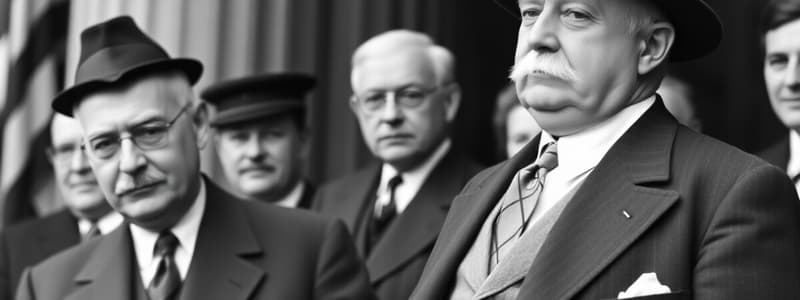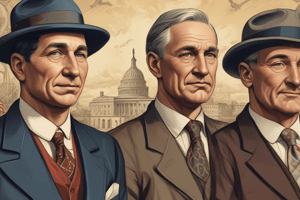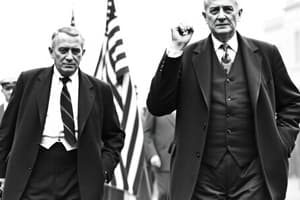Podcast
Questions and Answers
What was the primary goal of the League of Nations?
What was the primary goal of the League of Nations?
- To promote economic growth in member countries
- To provide humanitarian aid globally
- To maintain peace among nations (correct)
- To expand colonial territories
Which event is associated with the Teapot Dome Scandal?
Which event is associated with the Teapot Dome Scandal?
- Bribery and corruption in government drilling contracts (correct)
- Economic deregulation during the Great Depression
- A military conflict over oil reserves
- Public protests against the oil industry
What did Warren G. Harding promise to the American people upon his election?
What did Warren G. Harding promise to the American people upon his election?
- Increased global military involvement
- A continuation of progressive reforms
- Expansion of social programs
- A return to normalcy (correct)
What economic policy did Calvin Coolidge advocate during his presidency?
What economic policy did Calvin Coolidge advocate during his presidency?
What major event significantly ended the economic prosperity of the 1920s?
What major event significantly ended the economic prosperity of the 1920s?
Flashcards are hidden until you start studying
Study Notes
Political Changes in the 1920s
- Significant shift in American politics post-WWI, influenced by President Woodrow Wilson's failed League of Nations initiative.
- The era of progressive politics and liberal ideals of the 1910s shifted towards a conservative approach.
Harding's Presidency
- Warren G. Harding elected as Republican president in 1920, promoting a return to "normalcy."
- Tax cuts implemented under Harding’s administration helped revitalize the economy after recession.
- The administration faced major scandals, notably the Teapot Dome Scandal, resulting in corruption exposure.
- Albert Fall, Harding's Secretary of the Interior, convicted for bribery and mismanagement of federal oil reserves.
Transition to Coolidge
- Calvin Coolidge, former vice president, succeeded Harding and continued Republican leadership.
- Coolidge adopted pro-business policies, contributing to economic growth and prosperity in the 1920s.
- This period is often referred to as the "Roaring 20s" due to rapid economic expansion and cultural change.
Hoover's Presidency and Economic Collapse
- Herbert Hoover became president after Coolidge, inheriting an increasingly prosperous economy.
- The unexpected stock market crash in 1929 marked the end of the economic boom and initiated the Great Depression.
Studying That Suits You
Use AI to generate personalized quizzes and flashcards to suit your learning preferences.




